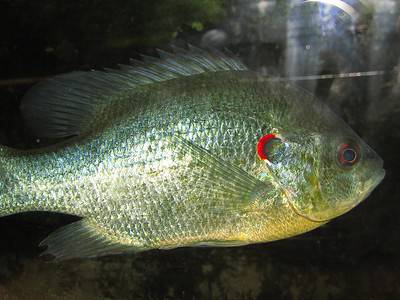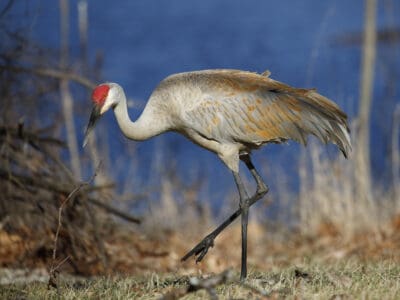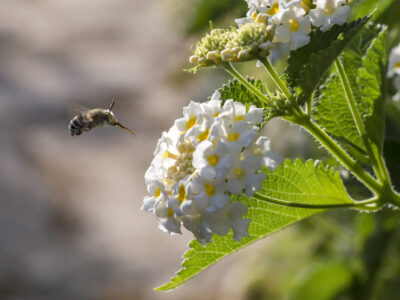Pennsylvania is a large, populous state situated in the northeastern mid-Atlantic region. One of the 13 original colonies, it is nicknamed the keystone state for its important geographic position between the other states. Delaware, Maryland, and West Virginia are located to the south. Ohio is to the west. New York, Lake Erie, and the Canadian province of Ontario are north. To the east, it is separated from New Jersey by the Delaware River, which runs into the Atlantic Ocean.
Pennsylvania is a land of diverse ecosystems. The Appalachian Mountains, which include the state’s highest point, Mount Davis, at 3,213 feet, run straight through the middle of the state. They are surrounded by dense forests, grasslands, hills, and wetlands. The Susquehanna River, which runs north to south from New York to the Chesapeake Bay, is the longest river located entirely within the state. Other important rivers include the Ohio and Allegheny. Together they account for much of the state’s diversity of freshwater wildlife.
The Official Animal of Pennsylvania

Great Dane is the official state dog of Pennsylvania.
©iStock.com/GlobalP
The state of Pennsylvania is officially represented by several different types of native wildlife. The state bird is the ruffed grouse, a medium-sized fowl that proved to be an important food source for the early settlers. The state dog is the Great Dane, a large hunting and working breed, once owned by the state’s founder, William Penn. The state fish is the brook trout; it’s one of the most common freshwater fish throughout the 4,000 miles of rivers and streams. The state insect is the firefly, which lights up the night sky in the summer. The official amphibian is the eastern hellbender, the largest species of salamander in North America. Finally, the official state animal is the white-tailed deer, a popular game animal.
Where to Find the Top Wild Animals in Pennsylvania
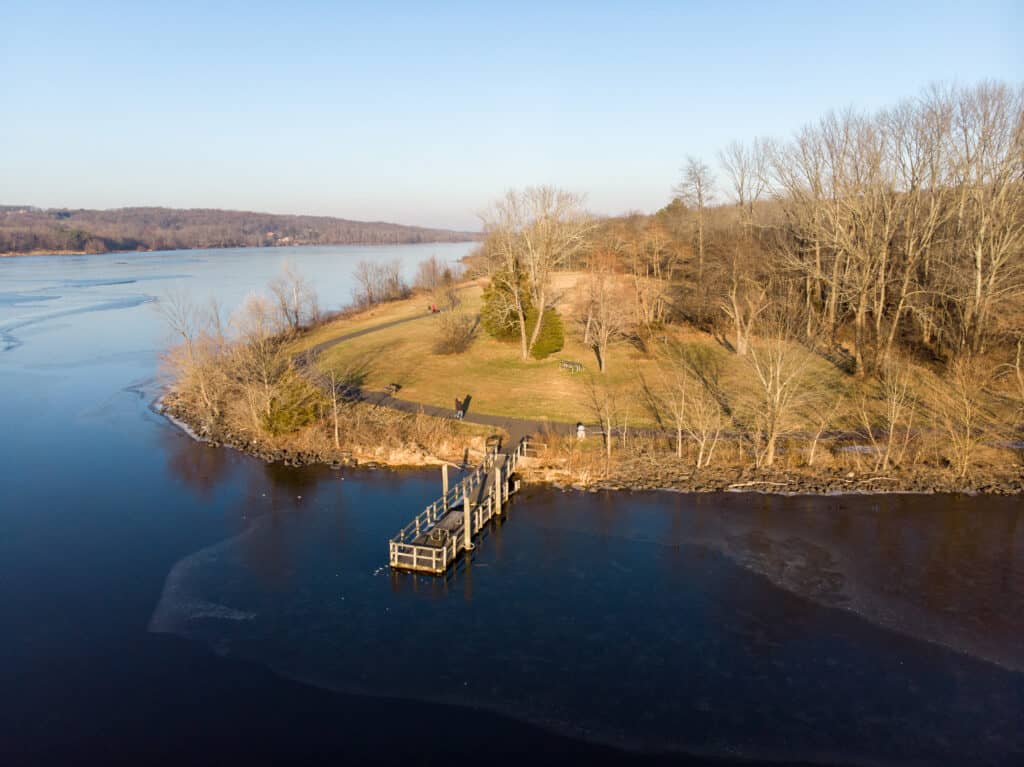
Peace Valley Park in Pennsylvania is a great place to spot wild animals.
©Dan Josephson/Shutterstock.com
The best places to find Pennsylvania’s most pristine and untouched wildlife are the numerous state and national parks and refuges dotted throughout the land. This list will cover the most popular destinations in the state.
State parks and refuges provide a safe haven for animals to live undisturbed from human activity. They are often home to some of the most endangered species, as well as abundant wildlife populations. These areas also help maintain healthy ecosystems by providing habitat for plants and animals alike. By protecting these lands, humans can ensure that wildlife is able to thrive in their natural habitats without disruption or destruction by development projects or other activities.
Additionally, state parks and refuges provide opportunities for people to observe wildlife in its natural setting while practicing responsible conservation methods such as limited access, no hunting/fishing policies, and environmental education programs. With so many advantages to protect Pennsylvania’s precious wild spaces, it’s no wonder why these places remain one of the best ways to experience nature at its finest!
- The Ohiopyle State Park, which covers some 19,000 acres in the Laurel Highlands of southwestern Pennsylvania, is a popular kayaking and water rafting destination. Amid the hiking trails and scenic waterfalls, visitors can expect to find plenty of deer, turkey, grouse, badgers, foxes, rodents, and other wildlife.
- The Delaware Water Gap National Recreation Area, which covers some 66,000 acres of the Pocono Mountains in the southeast, has some 100 miles of hiking trails where one can find rabbits, deer, rodents, and possibly even the elusive black bear.
- The Cherry Springs State Park, located in Potter County of north central Pennsylvania, is a prime destination for campers, hikers, and stargazers. Deer, otters, fishers, ospreys, hawks, nightjars, eagles, badgers, and black bears are all found here.
- Pymatuning State Park, located in the northeast of the state near the town of Crawford, covers around 21,000 acres of a manmade lake. The waters are teeming with largemouth and smallmouth bass, bluegill, walleye, carp, crappies, and other freshwater fish. It is open to fishing all year round.
- Presque Isle State Park, situated on some 3,000 acres of land around Lake Eerie, is a US National Natural Landmark. It’s also widely regarded as one of the best bird-watching sites in the state. Piping plovers, cerulean warblers, terns, sparrows, blackbirds, and gulls are all found here.
- Finally, Nockamixon State Park, located to the north of Philadelphia, is another good destination for bird-watching and freshwater fishing. More than 250 species of birds have been documented at the park, including orioles, warblers, swans, grebes, sandpipers, herons, kingfishers, ospreys, wrens, grosbeaks, and egrets.
Other animals that can be found in Pennsylvania include spiders, ticks, and black snakes.
The Most Dangerous Animals in Pennsylvania Today

Be careful around Timber Rattlesnakes that are highly venomous.
©Frode Jacobsen/Shutterstock.com
There are several dangerous animals in Pennsylvania. The most commonly encountered dangerous animal is the black bear. Although they are typically timid and unaggressive, if startled or provoked, a black bear can be very dangerous to humans. Black bears inhabit woodlands throughout the state of Pennsylvania but may also venture into suburban neighborhoods in search of food sources such as bird feeders or garbage cans.
Another potentially dangerous species is the timber rattlesnake. This venomous snake inhabits forests with rocky outcroppings and ledges, where it hunts small mammals and amphibians for food. When threatened by humans, these snakes will often coil up defensively and rattle their tails as a warning before striking out with their fangs which contain potent neurotoxic venom that can cause severe injury to people who come too close.
The forests of Pennsylvania may have once teemed with many dangerous predators, but today most of the dangerous animals are venomous snakes and insects, not carnivores. This list will only count wild animals that pose a direct danger to people. It will not include wild animals that incidentally harm people by spreading diseases.
- Timber Rattlesnake: Present throughout most of Pennsylvania, the timber rattlesnake can come in a few different color morphs, including yellow with dark bands and almost fully black. The long fangs, big size, and ability to inject a lot of venom at once make them potentially very dangerous. Fortunately, they are quite shy and non-aggressive around humans, and they will normally give a lengthy warning with their weird rattle before striking. If you’ve been bitten by this snake, however, then you should seek immediate medical attention. The anti-venom for this snake bite is quite effective.
- Eastern Copperhead: Another common forest-dwelling snake, the eastern copperhead, is identified by its pale brown body and darker markings that almost look like weird stains. While this snake will sometimes deliver a dry warning bite, the venom itself is quite potent and potentially lethal. Symptoms include pain, tingling, swelling, and nausea. Immediate medical attention is advised.
- Eastern Massasauga: Found only in western Pennsylvania, this species has a gray or tan body with rows of brown or black markings. It is normally quite shy and tries to avoid contact with humans, but once injected, the venom can destroy tissue and prevent blood clotting. Properly treated bite victims always make a full recovery.
- Black Widow Spider: The female of the black widow is the deadlier of the two sexes because of the larger venom gland. She is easily identified by her black body and red markings on the abdomen. Pain, cramps, and spasms are common symptoms of its bite, but death is exceptionally rare, even in untreated cases.
- Bees and Wasps: The sting from these flying insects can be exceptionally painful and annoying, but only a handful of deaths are known to occur each year, usually as a result of a severe allergic reaction.
- Black Bear: While not quite as dangerous as its fearsome reputation suggests, these large carnivores are certainly dangerous enough to kill a person. Most incidents occur when a mother is protecting her cubs. Sometimes people can be injured when their dog picks a fight with a bear. Fortunately, attacks are exceptionally unlikely, and deaths are even rarer.
3 Largest Animals in Pennsylvania
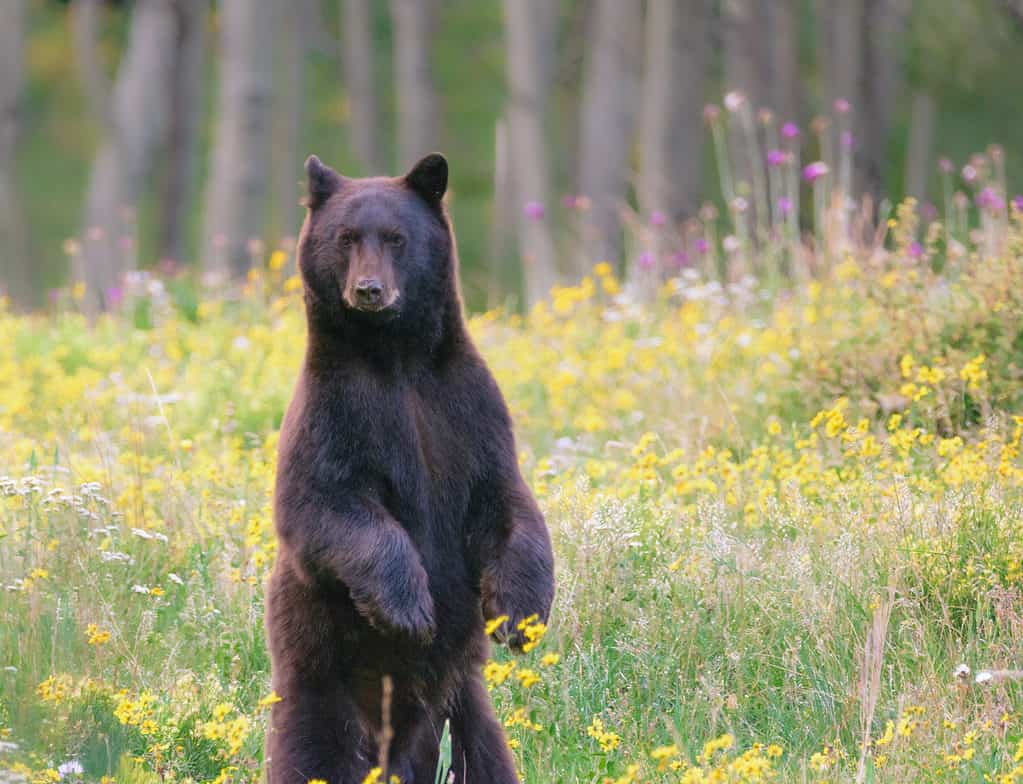
Black bears can stand five feet tall when on their hind legs.
©Constance Mahoney/Shutterstock.com
Pennsylvania is host to a variety of different species, some of which are quite large. The three largest animals in Pennsylvania are the black bear, white-tailed deer, and elk.
Black bears can weigh up to 400 pounds or more and stand five feet tall when on their hind legs. They inhabit forests, wetlands, and mountain regions throughout Pennsylvania. Black bears can be seen scavenging for food or searching for berries during warmer months while they hibernate in dens during colder months of the year.
White-tailed deer are among the most abundant mammals in Pennsylvania as well as its largest land mammal, with adult males weighing up to 200 pounds and standing 3 ½ feet tall at shoulder height. These animals prefer habitats that offer dense vegetation, such as meadows, marshes, woodlands, and agricultural lands, where they can feed on grasses, grains, and other plants throughout the day.
Pennsylvania is home to one of the largest herds of elk in the United States. The Eastern Elk, or wapiti, were once native to Pennsylvania but had been hunted almost completely out of existence by the late 1800s. In 1913, 25 elk from Yellowstone National Park were reintroduced into an area near Benezette, PA, and this herd has grown steadily since then. Today there are over 1,000 elk in Pennsylvania, with most of them concentrated around Elk County in north-central Pennsylvania. They can be seen throughout Pennsylvania’s state parks and game lands during certain times of the year when they migrate for food sources or rutting season. Elk have become a major tourist attraction in some areas due to their size and beauty. It’s not unusual for visitors to spot upwards of 50 animals on any given day!
3 Rarest Animals in Pennsylvania
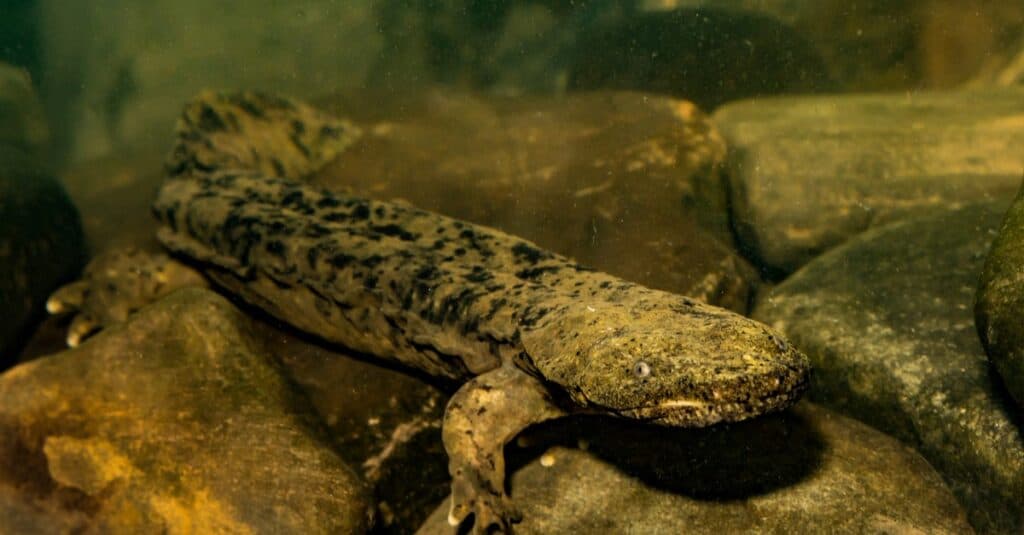
Eastern Hellbenders are rare animals to spot in Pennsylvania
©Jay Ondreicka/Shutterstock.com
There are a few rare animals in Pennsylvania. The Eastern hellbender salamander is the largest amphibian in North America and can be found living in clear, cold mountain streams.
Additionally, the Timber Rattlesnake is one of the most endangered species of venomous snake in Pennsylvania and has been listed as an endangered species since 1970.
Lastly, the Allegheny Woodrat can be found inhabiting rocky cliffs along rivers or caves across the state, but they are threatened by habitat loss due to development and fragmentation.
Endangered Animals in Pennsylvania
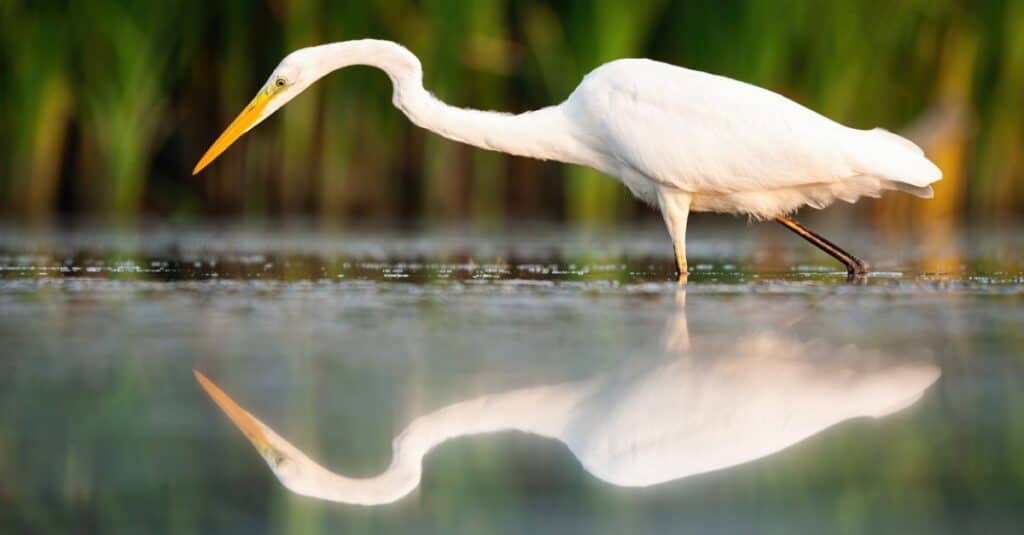
The great egret, ardea alba, is an endangered animal in Pennsylvania due to loss of habitat.
©WildMedia/Shutterstock.com
The state of Pennsylvania currently classifies species as either threatened or endangered based on their status within its borders. There are currently dozens of endangered species, many of which are listed below.
The cougar, moose, wolf, wolverine, and Canadian lynx were once native to Pennsylvania but are now extinct in the state. The main reason for this is due to human impact on their habitats. As cities and towns began developing across the state, these animals’ natural habitat was destroyed or altered significantly, which made it difficult for them to survive.
Additionally, hunting by humans has depleted populations of these species even further over time. These factors have combined to make it impossible for these animals to exist in Pennsylvania anymore. However, they still exist elsewhere in North America, where there is less human activity and more intact natural habitats allowing them to survive and thrive.
To prevent other animal species from becoming endangered, we need to work together as a society to protect our environment so that all creatures can live happily alongside us in nature.
The bald eagle and osprey have successfully recovered from previously low numbers thanks to the state’s conservation efforts. Here is a list of the endangered animals in Pennsylvania.
- Tricolored Bat: Easily identified by the presence of tricolored hair on the back, this species is currently threatened by the strange fungal disease known as white-nose syndrome, which spreads rapidly through the concentrated mass of hibernating bats in the winter. It causes widespread destruction by disrupting the bat’s natural hibernation cycle.
- Indiana Bat: This medium-sized mouse-eared bat is very common throughout the entire eastern United States, but it too is susceptible to the strange scourge of white-nose syndrome. Since 2006, entire populations have been completely wiped out or heavily reduced.
- North American Least Shrew: These tiny mammals, which measure only about 3 inches long, are currently classified as threatened in Pennsylvania and Connecticut due to the loss of freshwater habitats such as dunes and marshes.
- Piping Plover: A small shorebird, the piping plover is one of the rarest birds in Pennsylvania due to the loss of its important nesting sites, particularly around Lake Eerie.
- Great Egret: This large, long-necked, white-colored water bird is a very common sight all over the world. However, it does appear to be declining in Pennsylvania due to the loss of wetlands from clearing, drainage, and other factors.
- King Rail: This medium-sized water bird, which breeds in the marshes throughout the eastern United States, is in decline throughout Pennsylvania because of habitat loss.
- Black-crowned Night Heron: Easily identified by the combination of a white body and black crown and back, this medium-sized bird can be found in fresh and saltwater wetlands throughout the entire world. Unfortunately, in Pennsylvania, it is suffering greatly from habitat loss.
- Loggerhead Shrike: This is a small songbird with a white breast, black mask and wings, and pale gray back. It breeds in the northern United States and migrates south as far as Central America for the winter. Numbers have been declining in the country since the 1960s, perhaps as a result of pesticide use, habitat loss, human disturbances, or a combination of all three.
- Bog Turtle: As the smallest turtle in North America, the carapace of the bog turtle measures no more than about 4 inches. Loss or disruptions of their preferred wetland habitats, as well as their low reproductive rate, have made them one of the rarest turtles in the entire country. They are currently protected by the federal Endangered Species Act.
- Shortnose Sturgeon: The shortnose sturgeon is a large bottom-feeding fish that plies the waters off the coast of the US and then returns to freshwater habitats to lay its eggs. They are found throughout Delaware Bay and the surrounding river system, but water pollution, poaching, overfishing, and accidental boat strikes (combined with slow maturity and low birth rates) have all contributed to declining population numbers. It is now one of the rarest fishes in the area.
Native Plants in Pennsylvania
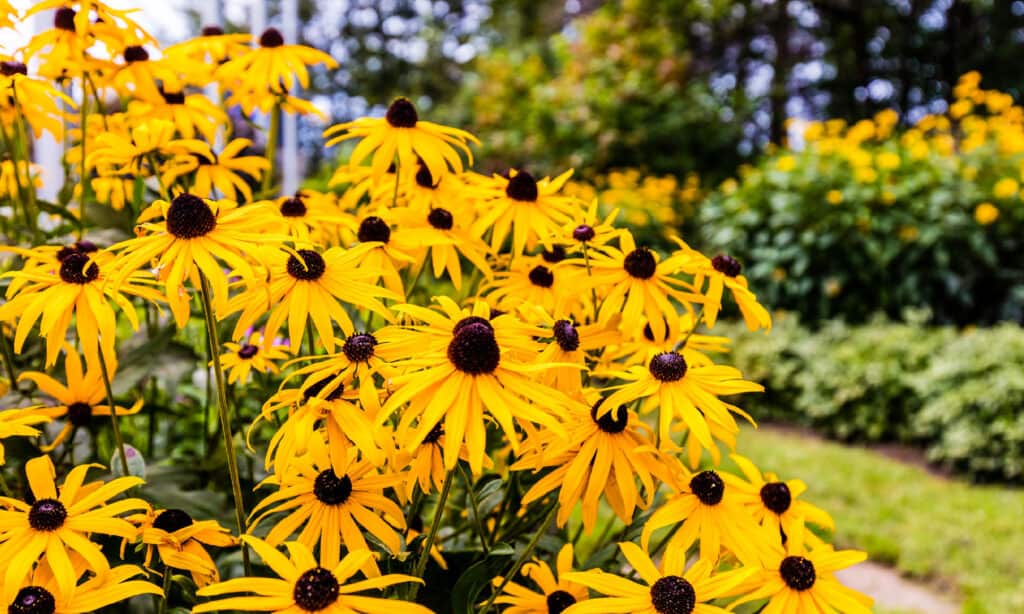
The black-eyed Susan is native to Pennsylvania and is a favorite in pollinator gardens.
©iStock.com/Dopeyden
Pennsylvania is home to a vast array of native wildflowers and plants, including the majestic mountain laurel, which blossoms every spring in woodlands and along streams. Other popular native species include Black-eyed Susans that grow in sunny areas such as meadows, fields, roadsides, and gardens. In the fall, you can see asters blooming. Goldenrods are very common and grow along roadsides and in wetland habitats.
Trilliums are common around woodland edges, and cowslip orchids grow near bogs and wet meadows rich with calcium-dense soils. Indian paintbrush or prairie fire flowers are commonly seen along dry prairies on rocky hillsides. All of these plants play an important role in Pennsylvania’s ecosystem by providing food for insects, birds, mammals, and other wildlife.
Pennsylvania has one of the most diverse geographies, and its territory is part of the eastern deciduous forest region. The state of Pennsylvania hosts around 3,400 species of plants, and a whole lot of them are native to the state. Some native plants in Pennsylvania include eastern redbud, black chokeberry, and swamp milkweed, among others.
The Flag of Pennsylvania
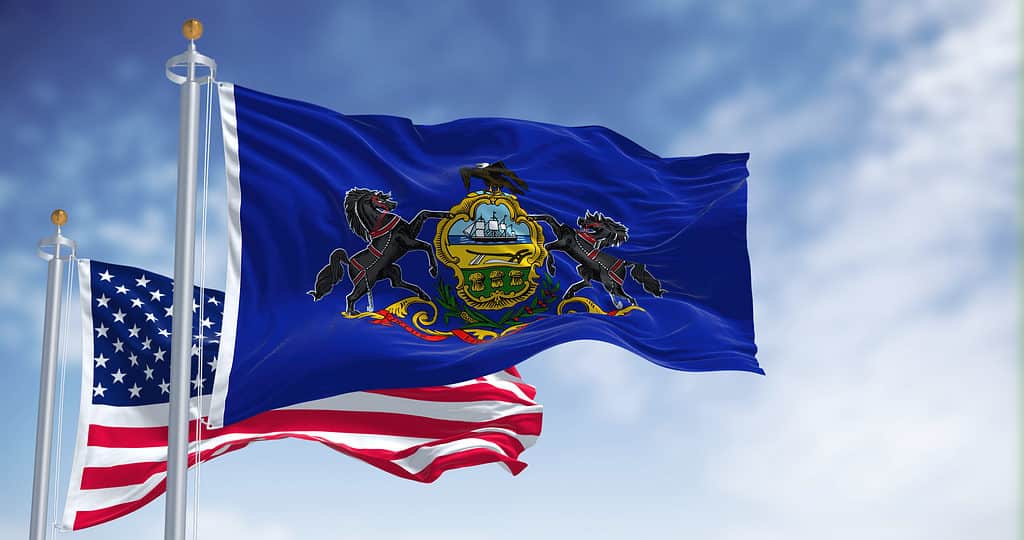
The Pennsylvania state flag is rich in symbolism.
©iStock.com/rarrarorro
The flag of Pennsylvania is an iconic symbol for the state, meant to represent its history and culture. The blue field on which the coat of arms is displayed represents justice, truth, loyalty, and peace. It also reflects the importance that Pennsylvania has placed on these values throughout its history.
The state coat of arms features a shield with two horses representing determination and strength in both physical and spiritual ways. Above this is a bald eagle, signifying protection from enemies as well as freedom from oppression. To either side of the shield are symbols of agriculture: an olive branch stands for peace, while a cornstalk beneath it signifies abundance and fertility.
Lastly, there are three golden sheaves of wheat which represent the diversity found within the state’s many different industries, such as manufacturing, farming, mining, etc. Altogether, these elements combine to form a powerful reminder of what it means to be a Pennsylvanian. One who works hard but also enjoys nature’s bounty in harmony with others around them.
Pennsylvania State Seal
The Pennsylvania state seal features a sailing ship, a clay-red plow, and three sheaves of wheat. The seal was made official in 1791.
More Articles Related to Pennsylvania
Read about:
- extinct animals that lived in Pennsylvania.
- the best national parks in Pennsylvania.
- the coldest place in Pennsylvania.
- the snowiest place in Pennsylvania.
- the most beautiful waterfalls in Pennsylvania.
- the best dog parks in Philadelphia, Pittsburgh, Pennsylvania.
- the Appalachian Trail in Pennsylvania.
Pennsylvanian Animals

Admiral Butterfly
Stunningly beautiful wings
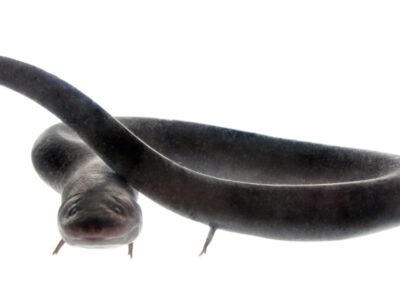
American Eel
Don't eat raw eel! Their blood is poisonous to humans when consumed raw.

Armyworm
They are so named because they "march" in armies of worms from one crop to another in search of food
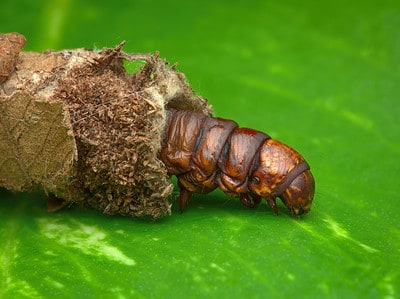
Bagworm Moth Caterpillar
They continually enlarge their protective cases

Beewolf wasp
They hunt bees
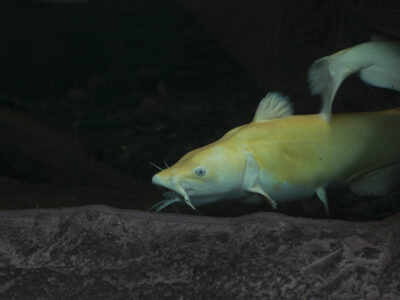
Blue Catfish
It's a strong fighter when caught on a fishing line

Brook Trout
The Brook Trout is actually part of the salmon family, making it not technically a trout.
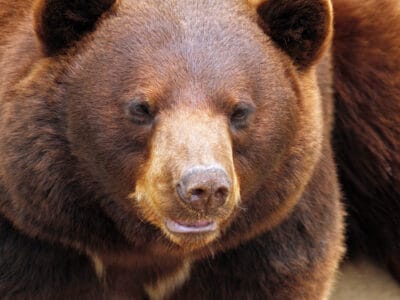
Cinnamon Bear
A newborn cinnamon bear weighs 1/2 pound -- about the same as a large apple.

Common Yellowthroat
The Common Yellowthroat stays close to the ground and uses stealth to survive!
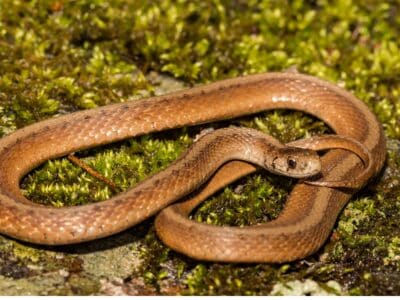
De Kay’s Brown Snake
They have specialized jaws for removing snails from shells.
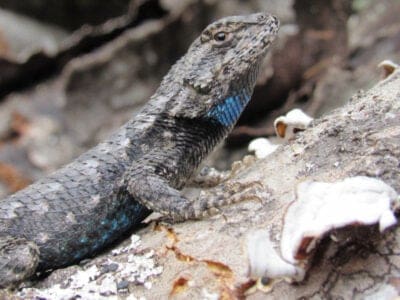
Eastern Fence Lizard
Females are usually larger than males.

Eastern Hognose Snake
Eastern hognose snakes are venomous, but only to frogs and toads.

Eastern Rat Snake
Rat snakes are medium-to-large, nonvenomous snakes that kill by constriction.

Flea
Adult fleas can jump up to 7 inches in the air
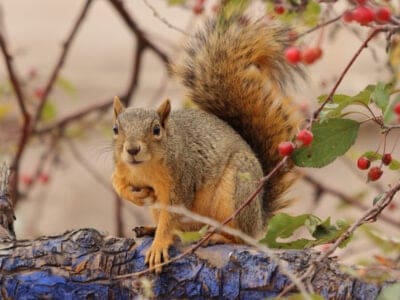
Fox Squirrel
Although it is a tree squirrel, it spends most of its time on the ground.
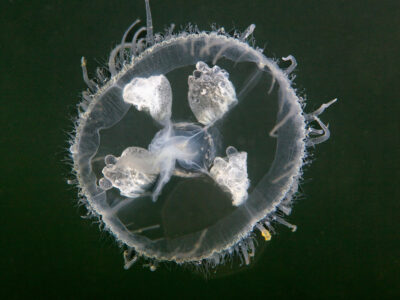
Freshwater Jellyfish
The freshwater jellyfish is native to China but is now found all over the world

Groundhog (Woodchuck)
They whistle to each other to warn of approaching danger!

Kentucky Warbler
The Kentucky Warbler appears to wear bright yellow cat-eye glasses!
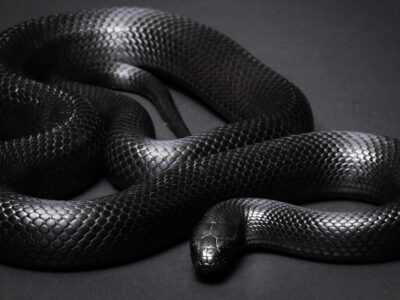
King Snake
King Snakes eat other types of snakes.

Massasauga
The name “Massasauga” comes from the Chippewa language, meaning “Great River Mouth”.

Mealybug
They have a symbiotic relationship with ants.

Mockingbird
Mockingbirds are incredible mimics that can learn hundreds of songs!
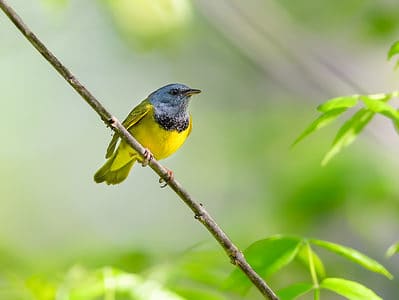
Mourning Warbler
The Mourning Warbler was named for its gray head, which resembles a mourning veil!

Nematode
Nematodes range in size from 1/10 of an inch to 28 feet long

Orb Weaver
Females are about four times the size of males

Owl
The owl can rotate its head some 270 degrees
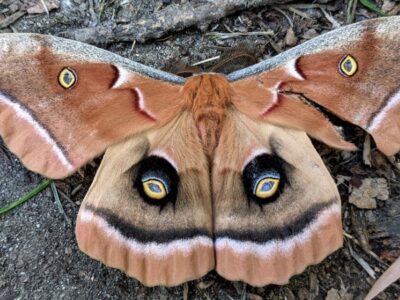
Polyphemus Moth
The Polyphemus moth doesn’t and can't eat, except when it's a caterpillar!
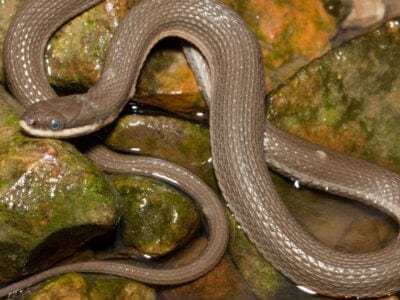
Queen Snake
Queen snakes have armor-like scales on the top of their head

Rat Snakes
Rat snakes are constrictors from the Colubridae family of snakes.

Red-Bellied Woodpecker
Red-Bellied Woodpeckers will often steal the nests of other birds.
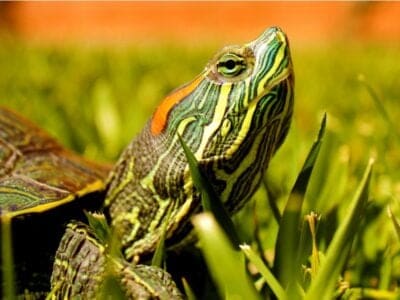
Red-Eared Slider
Sliders spend lots of time basking in the sun. As cold-blooded animals, they need the sun to heat up.
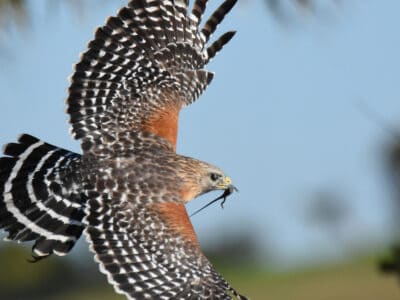
Red-Shouldered Hawk
Red-Shouldered Hawks reuse the same nesting area each year.

Rooster
Will mate with the entire flock!
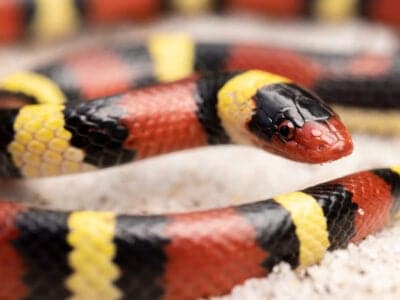
Scarlet Kingsnake
Scarlet kingsnake’s pattern is an example of Batesian mimicry.
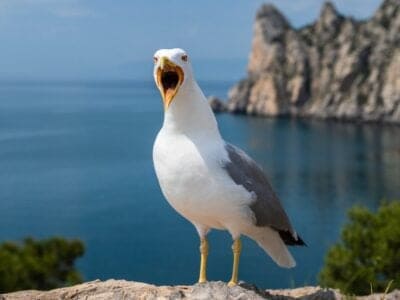
Seagull
Some gulls are capable of using tools

Smallmouth Bass
A fierce fighter!

Smokybrown Cockroach
Has up to 45 eggs per egg case
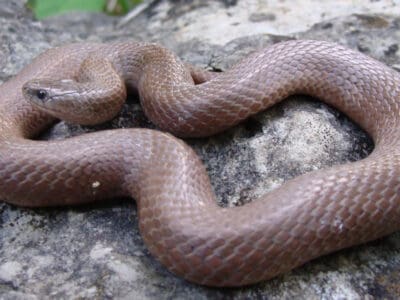
Smooth Earth Snake
Valeria Biddle Blaney (1828-1900) collected the first specimen in Maryland.

Tiger Trout
As tiger trout are sterile, they cannot produce offspring. However, they do have relatively long lifespans and can live up to 10 years in captivity.

Tree Cricket
They make music with their wings
Pennsylvanian Animals List
- Admiral Butterfly
- American Eel
- Armyworm
- Bagworm Moth Caterpillar
- Beewolf wasp
- Blue Catfish
- Brook Trout
- Cinnamon Bear
- Common Yellowthroat
- De Kay’s Brown Snake
- Dire Wolf
- Eastern Fence Lizard
- Eastern Hognose Snake
- Eastern Rat Snake
- Flea
- Fox Squirrel
- Freshwater Jellyfish
- Groundhog (Woodchuck)
- Kentucky Warbler
- King Snake
- Massasauga
- Mealybug
- Milk Snake
- Mockingbird
- Mourning Warbler
- Nematode
- Orb Weaver
- Owl
- Polyphemus Moth
- Queen Snake
- Rat Snakes
- Red-Bellied Woodpecker
- Red-Eared Slider
- Red-Shouldered Hawk
- Redear Sunfish
- Rooster
- Sandhill Crane
- Scarlet Kingsnake
- Seagull
- Smallmouth Bass
- Smokybrown Cockroach
- Smooth Earth Snake
- Southeastern Blueberry Bee
- Swallowtail Butterfly
- Tiger Trout
- Tree Cricket
- Yellowish Cuckoo Bumblebee (formerly Fernald’s Cuckoo Bumblebee)
Animals in Pennsylvania FAQs (Frequently Asked Questions)
What kinds of animals live in Pennsylvania?
The most common native mammals that live in Pennsylvania are opossums, moles and shrews, bats, rabbits, raccoons, foxes, skunks, otters, minks, badgers, weasels, deer, and rodents (such as squirrels, chipmunks, voles, mice, and rats). The most common birds are blue jays, finches, cardinals, ducks, geese, warblers, sparrows, wrens, grouses, and birds of prey. The state is also rich in salamanders, frogs, and toads, turtles, snakes, freshwater fish, insects, mussels, and other invertebrates.
How many species of animals live in Pennsylvania?
Pennsylvania has more than 60 native mammals, around 400 birds, 40 reptiles, and 36 amphibians. By far the most common animals, though, are invertebrates. There are some 11,500 documented species in the state, but this only represents about half of the invertebrates thought to exist in the wild.
What predators live in Pennsylvania?
Foxes, black bears, badgers, weasels, and minks are the main predators living in Pennsylvania. All these carnivores but the black bear pose little danger to people.
What is the strangest animal in Pennsylvania?
One of the more strange looking wild animals may be the star-nosed mole. The snout is covered in weird writhing tentacles that form a star-shaped pattern. But these tentacles are actually some of the most sensitive instruments in the entire animal kingdom. The mole can react very quickly to the presence of prey in its underground burrows – almost as fast as its nerves can react.
Do moose live in Pennsylvania?
The moose may have disappeared in the state at some point in the 18th or 19th century due to early colonial overhunting.




